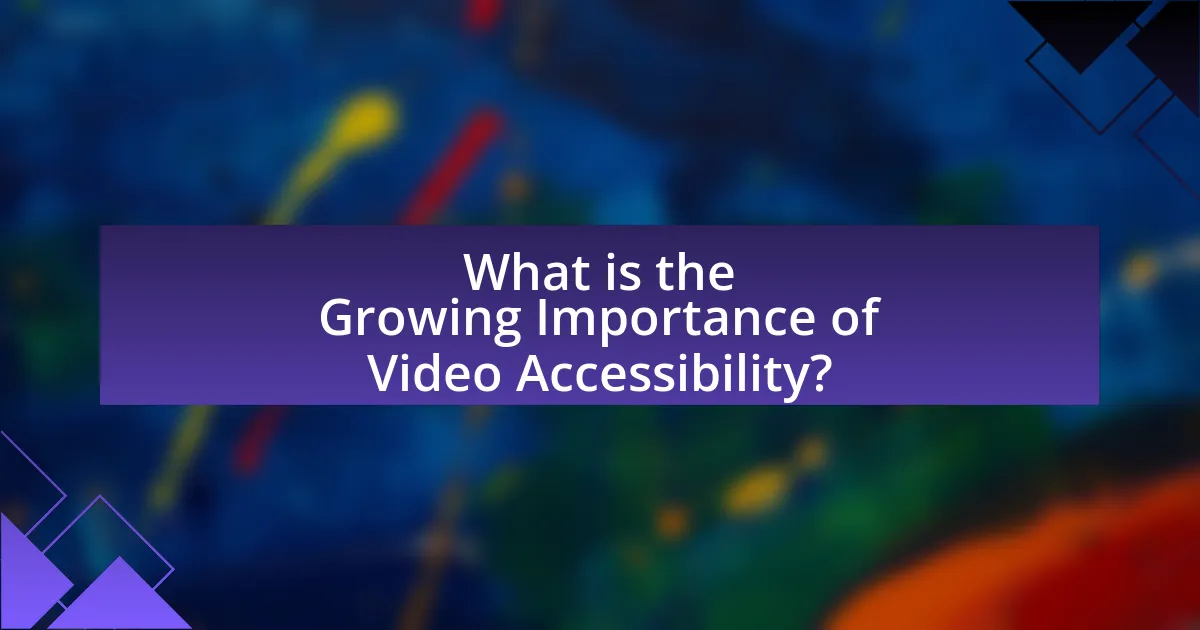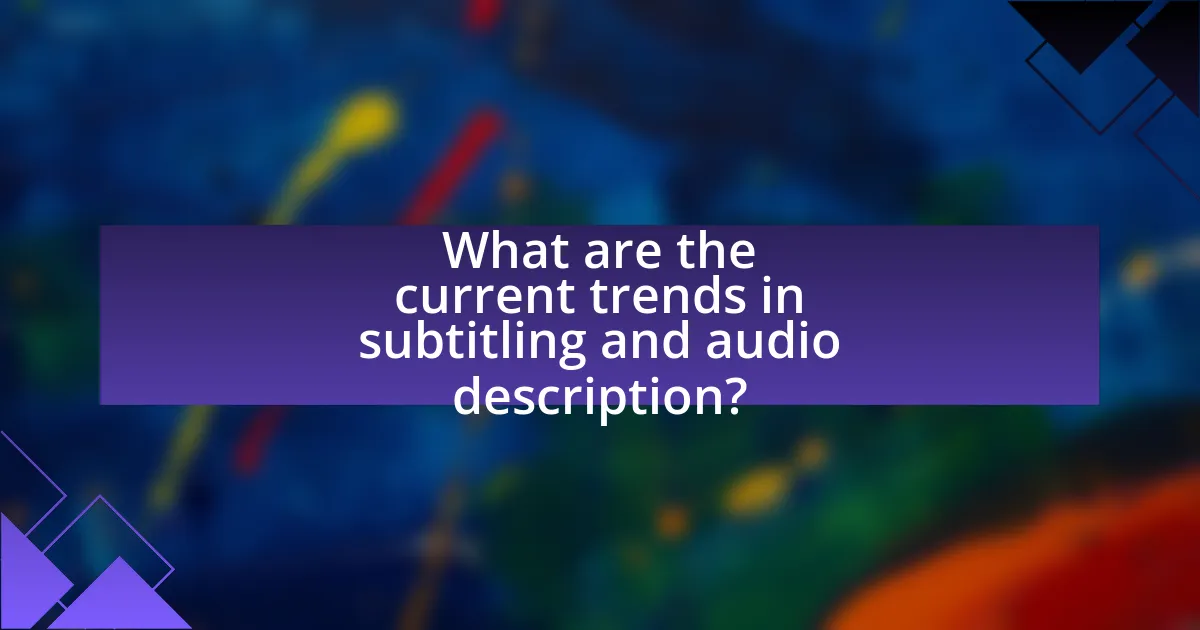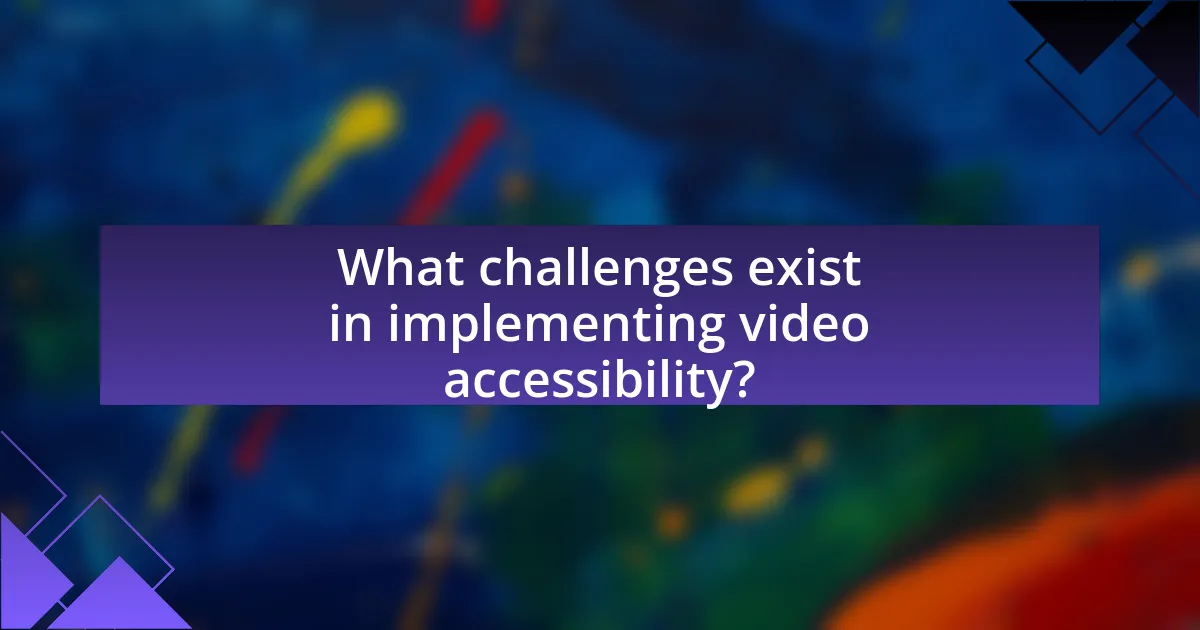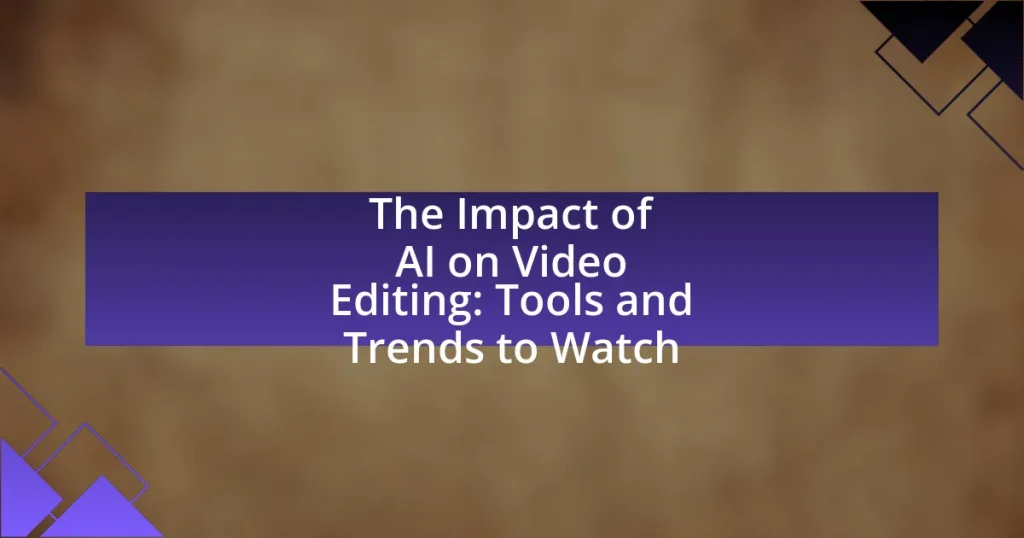Video accessibility is a critical aspect of digital media that ensures individuals with disabilities can engage with video content. As video consumption continues to rise, legal mandates such as the Americans with Disabilities Act necessitate the inclusion of features like subtitling and audio descriptions. This article explores the growing importance of video accessibility, highlighting statistics that underscore the need for inclusive practices, the impact of accessibility on various demographics, and the role of technology in enhancing subtitling and audio description. Additionally, it addresses current trends, legal requirements, challenges in implementation, and best practices for organizations to improve accessibility in their video content.

What is the Growing Importance of Video Accessibility?
Video accessibility is increasingly important as it ensures that all individuals, including those with disabilities, can access and engage with video content. The rise in digital media consumption, with over 80% of internet traffic projected to be video by 2025, highlights the necessity for inclusive practices. Furthermore, legal requirements, such as the Americans with Disabilities Act, mandate accessibility, pushing organizations to adopt subtitling and audio description. Studies show that accessible videos can increase audience reach by up to 30%, demonstrating the tangible benefits of inclusivity in media.
Why is video accessibility becoming a critical issue today?
Video accessibility is becoming a critical issue today due to the increasing demand for inclusive content that accommodates diverse audiences, including individuals with disabilities. As of 2021, approximately 15% of the global population experiences some form of disability, highlighting the necessity for accessible video formats such as captions and audio descriptions. Furthermore, legal requirements, such as the Americans with Disabilities Act and the European Accessibility Act, mandate that digital content be accessible, driving organizations to prioritize video accessibility to comply with regulations and avoid legal repercussions. The rise of online platforms and streaming services has also amplified the need for accessibility, as consumers expect equal access to information and entertainment.
What are the statistics highlighting the need for video accessibility?
Approximately 1 in 5 people in the United States has a disability, highlighting the critical need for video accessibility. According to the World Health Organization, over 1 billion individuals globally experience some form of disability, which can hinder their ability to access video content. Furthermore, a study by the National Association of the Deaf indicates that 90% of deaf individuals rely on captions to understand video content. Additionally, research from the Pew Research Center shows that 80% of consumers are more likely to watch a video if it has captions. These statistics underscore the necessity for accessible video content to ensure inclusivity for all audiences.
How does video accessibility impact different demographics?
Video accessibility significantly impacts different demographics by enhancing inclusivity and engagement for individuals with disabilities, non-native speakers, and varying age groups. For instance, individuals with hearing impairments benefit from subtitles, which allow them to access content that would otherwise be inaccessible. Research indicates that approximately 15% of the global population experiences some form of hearing loss, highlighting the necessity of subtitles for this demographic.
Non-native speakers also gain from video accessibility features, as subtitles can aid in language comprehension and learning. A study published in the Journal of Educational Technology & Society found that students who used subtitles while watching educational videos performed better in language acquisition.
Additionally, older adults, who may face challenges with auditory processing, can find video content more approachable when it includes audio descriptions and subtitles. According to the Pew Research Center, 46% of adults aged 65 and older report having difficulty hearing, underscoring the importance of accessible video content for this age group.
Overall, video accessibility fosters a more inclusive environment, allowing diverse demographics to engage with content effectively.
What role do subtitling and audio description play in video accessibility?
Subtitling and audio description are essential components of video accessibility, enabling individuals with hearing and visual impairments to engage with content. Subtitling provides text representations of spoken dialogue and relevant sound effects, allowing deaf or hard-of-hearing viewers to understand the audio elements of a video. According to the World Health Organization, over 5% of the world’s population experiences disabling hearing loss, highlighting the necessity of subtitles for inclusive media consumption.
Audio description, on the other hand, offers verbal narration of visual elements, such as actions, settings, and facial expressions, which assists blind or visually impaired viewers in comprehending the visual context of a video. The American Council of the Blind states that approximately 7.6 million Americans are visually impaired, underscoring the importance of audio descriptions in making visual media accessible. Together, these features significantly enhance the inclusivity of video content, ensuring that diverse audiences can fully experience and understand the material presented.
What are the definitions and differences between subtitling and audio description?
Subtitling is the process of displaying text on a screen to provide a written representation of the spoken dialogue in a video, while audio description is a narration that conveys visual elements of a video to assist individuals who are blind or visually impaired. The primary difference lies in their purpose: subtitling focuses on translating spoken language into text for viewers who can hear but may not understand the language, whereas audio description provides additional commentary on visual aspects, such as actions, settings, and facial expressions, to enhance understanding for those who cannot see the visuals. This distinction highlights the unique roles each serves in making video content accessible to diverse audiences.
How do subtitling and audio description enhance viewer experience?
Subtitling and audio description significantly enhance viewer experience by making content accessible to a broader audience, including those who are deaf, hard of hearing, or visually impaired. Subtitling provides text representation of spoken dialogue and sound effects, allowing viewers to follow the narrative without relying solely on audio. Research indicates that approximately 5% of the global population experiences hearing loss, highlighting the necessity of subtitles for inclusivity. Audio description narrates visual elements, such as actions and settings, enabling visually impaired viewers to understand the context and emotions conveyed in the content. A study by the World Health Organization found that 2.2 billion people globally have vision impairment, underscoring the importance of audio descriptions in enhancing their viewing experience. Together, these accessibility features not only improve comprehension but also foster a more inclusive viewing environment, allowing diverse audiences to engage with media content fully.

What are the current trends in subtitling and audio description?
Current trends in subtitling and audio description include the increasing use of AI technology for automated captioning and the demand for multilingual accessibility. AI-driven tools enhance the speed and accuracy of subtitle generation, while the rise in global content consumption necessitates subtitles in multiple languages to reach diverse audiences. Additionally, there is a growing emphasis on inclusive design, ensuring that audio descriptions are not only accurate but also contextually rich, providing a better experience for visually impaired viewers. These trends reflect a broader commitment to making video content accessible to all, aligning with legal requirements and audience expectations for inclusivity.
How is technology influencing subtitling and audio description practices?
Technology is significantly influencing subtitling and audio description practices by enhancing accuracy, efficiency, and accessibility. Automated transcription and translation tools, powered by artificial intelligence, allow for quicker generation of subtitles, reducing the time required for manual input. For instance, advancements in speech recognition technology have improved the precision of automated subtitles, achieving accuracy rates above 90% in many cases. Additionally, machine learning algorithms are being utilized to create more contextually relevant audio descriptions, ensuring that visually impaired audiences receive richer and more informative content. These technological innovations not only streamline the production process but also expand the reach of video content to diverse audiences, thereby promoting inclusivity in media consumption.
What advancements in AI are shaping the future of subtitling?
Advancements in AI that are shaping the future of subtitling include improved natural language processing, real-time translation capabilities, and automated speech recognition. Natural language processing enhances the accuracy of subtitle generation by understanding context and nuances in dialogue, which leads to more coherent and contextually relevant subtitles. Real-time translation capabilities allow for instant subtitling in multiple languages, making content accessible to a global audience. Automated speech recognition technology has significantly reduced the time required to create subtitles by accurately transcribing spoken language into text, as evidenced by systems like Google’s Speech-to-Text, which boasts over 95% accuracy in ideal conditions. These advancements collectively contribute to making video content more accessible and inclusive.
How are streaming platforms adapting to include audio description?
Streaming platforms are increasingly integrating audio description to enhance accessibility for visually impaired users. Major services like Netflix, Amazon Prime Video, and Disney+ have expanded their audio description offerings, providing narrated descriptions of visual elements during programming. For instance, Netflix reported that as of 2021, it had over 1,000 titles available with audio descriptions, reflecting a commitment to inclusivity. Additionally, platforms are collaborating with advocacy groups to ensure that audio descriptions meet industry standards and user needs, further solidifying their role in promoting accessibility in media consumption.
What are the legal requirements surrounding video accessibility?
Legal requirements surrounding video accessibility primarily stem from the Americans with Disabilities Act (ADA) and Section 508 of the Rehabilitation Act. The ADA mandates that public accommodations, including websites and online content, must be accessible to individuals with disabilities, which encompasses video content. Section 508 requires federal agencies to ensure that their electronic and information technology is accessible to people with disabilities, including providing captions and audio descriptions for video content. These laws have been reinforced by various court rulings, emphasizing the necessity for compliance to avoid discrimination against individuals with disabilities.
What laws mandate the use of subtitles and audio descriptions?
The Americans with Disabilities Act (ADA) mandates the use of subtitles and audio descriptions for public accommodations, ensuring accessibility for individuals with hearing and visual impairments. Additionally, the Twenty-First Century Communications and Video Accessibility Act (CVAA) requires that video programming be accessible to people with disabilities, which includes the provision of closed captions and audio descriptions. These laws are designed to promote equal access to media content, reflecting the legal obligation to accommodate individuals with disabilities in various public and commercial settings.
How do these regulations vary across different countries?
Regulations regarding video accessibility, including subtitling and audio description, vary significantly across countries. For instance, the United States mandates accessibility through the Americans with Disabilities Act and the 21st Century Communications and Video Accessibility Act, requiring closed captions for television and online video content. In contrast, the European Union has established the Audiovisual Media Services Directive, which obligates member states to ensure accessibility for people with disabilities, leading to diverse implementations in countries like the UK, where Ofcom enforces strict captioning requirements, and France, which has specific quotas for audio description in broadcast media. These differences reflect varying cultural attitudes towards accessibility and the legal frameworks supporting it, demonstrating that while the goal of inclusivity is shared, the methods and rigor of enforcement differ widely.

What challenges exist in implementing video accessibility?
Implementing video accessibility faces several challenges, including the lack of standardized guidelines, insufficient funding, and the need for specialized skills. The absence of universally accepted standards, such as those outlined in the Web Content Accessibility Guidelines (WCAG), complicates the creation of accessible video content. Additionally, many organizations struggle with limited budgets, which can hinder the investment in necessary technologies and resources for accessibility features like captions and audio descriptions. Furthermore, the requirement for trained personnel to produce high-quality accessibility features adds another layer of difficulty, as there is often a shortage of professionals with expertise in this area. These factors collectively impede the effective implementation of video accessibility.
What are the common barriers to effective subtitling and audio description?
Common barriers to effective subtitling and audio description include linguistic challenges, timing issues, and technical limitations. Linguistic challenges arise when the source language contains idiomatic expressions or cultural references that are difficult to translate accurately. Timing issues often occur when subtitles do not sync well with the audio, leading to confusion for viewers. Technical limitations can involve inadequate software or hardware that fails to support high-quality audio description or subtitling features. These barriers hinder the accessibility of video content, impacting the experience for individuals with hearing or visual impairments.
How do budget constraints affect the quality of accessibility features?
Budget constraints significantly reduce the quality of accessibility features in video content. When financial resources are limited, organizations often prioritize essential functions over comprehensive accessibility, leading to subpar subtitling and audio description services. For instance, a study by the World Health Organization indicates that inadequate funding can result in fewer trained professionals available to create high-quality accessibility features, ultimately compromising the user experience for individuals with disabilities.
What skills are necessary for creating high-quality subtitles and audio descriptions?
Creating high-quality subtitles and audio descriptions requires strong language proficiency, attention to detail, and an understanding of the content’s context. Language proficiency ensures accurate translation and transcription, while attention to detail is crucial for timing and synchronization. Understanding the content’s context allows for appropriate tone and nuance in descriptions. Research indicates that effective subtitling and audio description enhance accessibility, making media more inclusive for individuals with hearing or visual impairments.
How can organizations improve their video accessibility efforts?
Organizations can improve their video accessibility efforts by implementing closed captions and audio descriptions in their video content. Closed captions provide text representation of spoken dialogue and sound effects, making videos accessible to individuals who are deaf or hard of hearing. According to a study by the National Association of the Deaf, 90% of people who are deaf or hard of hearing rely on captions to understand video content. Additionally, audio descriptions narrate visual elements for individuals who are blind or have low vision, enhancing their understanding of the video. The American Council of the Blind emphasizes that audio descriptions can significantly improve the viewing experience for visually impaired audiences. By adopting these practices, organizations can ensure their video content is inclusive and accessible to a broader audience.
What best practices should be followed for effective subtitling?
Effective subtitling requires adherence to several best practices, including accuracy, synchronization, and readability. Accuracy ensures that the subtitles convey the correct meaning of the spoken dialogue, which is crucial for maintaining the integrity of the content. Synchronization involves timing the subtitles to match the audio, allowing viewers to follow along without confusion. Readability focuses on using clear fonts, appropriate sizes, and contrasting colors to enhance visibility, ensuring that viewers can easily read the text without straining. Additionally, limiting the number of characters per line and the duration of each subtitle helps maintain viewer engagement and comprehension. These practices are supported by research indicating that well-executed subtitles significantly improve accessibility for diverse audiences, including those with hearing impairments.
How can audio description be optimized for various content types?
Audio description can be optimized for various content types by tailoring the descriptive language and pacing to match the specific visual elements and narrative style of each type. For instance, in films, audio descriptions should focus on key visual actions, character expressions, and scene changes, while in educational videos, they should emphasize diagrams, charts, and important visual cues that support learning objectives. Research indicates that effective audio descriptions enhance comprehension and engagement, particularly in diverse content formats, as they provide essential context that may not be conveyed through dialogue alone.
What practical steps can be taken to enhance video accessibility?
To enhance video accessibility, implement closed captioning and audio descriptions. Closed captioning provides text for spoken dialogue and sound effects, making content accessible to individuals with hearing impairments. According to the National Association of the Deaf, 1 in 4 adults in the U.S. has some degree of hearing loss, highlighting the necessity of this feature. Audio descriptions narrate visual elements for those with visual impairments, ensuring they can fully engage with the content. Research from the World Health Organization indicates that over 2.2 billion people globally have vision impairment, underscoring the importance of this accessibility measure. Additionally, using accessible video players that support keyboard navigation and screen readers further enhances usability for all viewers.
How can content creators ensure compliance with accessibility standards?
Content creators can ensure compliance with accessibility standards by following established guidelines such as the Web Content Accessibility Guidelines (WCAG). These guidelines provide specific criteria for making content perceivable, operable, understandable, and robust for individuals with disabilities. For instance, creators should implement features like captions for videos, audio descriptions for visual content, and ensure that all interactive elements are keyboard accessible. Adhering to these standards not only enhances accessibility but also broadens audience reach, as approximately 15% of the global population experiences some form of disability, according to the World Health Organization.
What tools and resources are available for improving video accessibility?
Tools and resources available for improving video accessibility include captioning software, audio description services, and accessibility guidelines. Captioning software like Rev and Amara allows users to create accurate subtitles, enhancing comprehension for viewers with hearing impairments. Audio description services, such as those provided by Descriptive Video Works, offer narrated descriptions of visual elements, aiding viewers with visual impairments. Additionally, resources like the Web Content Accessibility Guidelines (WCAG) provide comprehensive standards for making video content accessible, ensuring compliance with legal requirements and best practices. These tools and resources collectively contribute to a more inclusive viewing experience for all audiences.



